General Health Information
1. Vaccinations
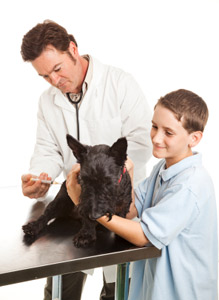
A basic (but very important) part of your dog’s healthcare is vaccination. There is some debate over whether or not vaccinations are necessary for all dogs. Some owners feel that their dog does not have enough contact with the outside world to necessitate a variety of shots. While this is a question that every owner will have to answer for themselves, the rabies vaccine is required by law, so whether or not your dog is given the rabies shot is not an option. And many dogs spend lots of time outside, playing in the grass and interacting with other dogs and people, so having them vaccinated for a variety of things will only be beneficial for them.
While vaccinations do not protect dogs from all diseases and disorders, if your dog receives initial vaccinations as a puppy, followed up with annual booster shots throughout his lifetime, he stands a good chance of being free of disease and living a long and healthy life.
2. Fleas

If you notice your dog spending a lot of time scratching himself, there’s a good chance he’s got fleas. To make sure, separate a patch of his fur so you can see his skin. If you notice a lot of tiny black specs (flea excrement), your dog most likely has fleas. Fleas are the most difficult external parasite to get rid of because they reproduce extremely fast and also because they can become resistant to insecticides. Your veterinarian can help you to rid of fleas both from your dog and your home and protect your dog from fleas later on.
3. Ticks
Ticks are more than just a nuisance, as they often carry diseases. They feed off their host’s blood by burrowing their mouths into the skin, so a disease can be easily passed from tick to animal. Ticks can easily be spotted on short coated dogs, but finding a tick on a dog with a longer coat can be challenging. It’s important to check your dog for ticks often, especially if he spends a lot of time in wooded or grassy places. On dogs, ticks tend to prefer areas near the ears, head, and neck, so check these spots most often.
You should consult your vet to remove the tick. If you think your dog may have contracted a tick-borne disease, get him to the veterinarian as soon as possible.
4. Allergies
Allergies have become a huge problem for both animals and humans. Allergies specific to dogs are grouped into four categories: flea, atopic or inhalant, food, and contact.
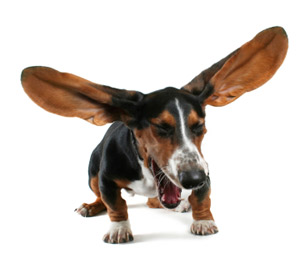 Flea
Flea
The flea allergy is the most common type. It isn’t an allergy to actual fleas but to a protein in flea saliva that is left in the skin after a flea bite. Severe reactions to this allergy can really depress your dog, so you should ask your veterinarian for ways to keep this allergy under control.
Inhalant
Inhalant allergies are the second most common type of allergy in dogs. They occur when a dog breathes in certain allergens, such as pollen, tobacco smoke, or mold spores. Talk to a veterinarian for treatment suggestions.
Food
Dogs are often allergic to the same foods that humans are allergic to, such as soy, milk, eggs, wheat, or corn. Usually a dog’s reaction to a food allergy is itchy, irritated skin, but some may respond with vomiting or diarrhea. It may take some time and effort to figure out exactly what your dog is allergic to, but once you know, it shouldn’t be too difficult to adjust his diet. There are certain dog foods that are suitable for dogs with allergies.
Contact
When a dog has contact allergies, a reaction occurs when he/she physically touches a substance that contains an allergen, such as plastic, grass, or wool. Contact allergies usually require regular allergy shots to keep them under control, and lifestyle changes may also be necessary. Talk to a veterinarian for treatment suggestions..
Obesity
Obesity is the most common nutrition-related health problem for dogs. Some experts estimate that 25 to 44 percent of dogs are obese. You may think that it’s no big deal for your dog to gain a few extra pounds, but you’re wrong—just a couple of pounds can be significant. For example, an extra 2 kilograms on a dog that should weigh 8 kilograms is equivalent to an extra 20 kilograms on a person who should weigh 80. Dogs that are obese can develop diabetes, respiratory problems, and gastrointestinal disorders.
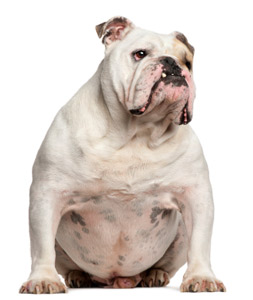 Signs of Obesity
Signs of Obesity
It is easy for obesity to sneak up on you. One day you may suddenly look at your dog and wonder when he put on so many extra pounds! Dogs who maintain a healthy weight for years on the same amount of food may slowly start to gain weight as their exercise level and metabolism decline as they reach their senior years.
It is easy for obesity to sneak up on you. One day you may suddenly look at your dog and wonder when he put on so many extra pounds! Dogs who maintain a healthy weight for years on the same amount of food may slowly start to gain weight as their exercise level and metabolism decline as they reach their senior years.
What to Do
Before treating your dog for obesity, take him to the veterinarian, because obesity can be caused by conditions other than overeating. Hypothyroidism and diabetes, for example, are two common causes of obesity. However, if your dog’s obesity is determined (usually via a blood test) to be caused by excessive calorie intake, you and your vet can develop an effective treatment plan including reducing the quantity of food at mealtimes or adjusting your dog’s diet to make it higher in fiber and lower in fat. Like with a human weight loss program, moderate exercise should also be included.
First Aid
All dog owners hope that their dog will avoid injury, and many take precautions to try to make sure this is the case. But what if the worst happens and your dog is injured in some way? You need to be prepared to give him/her the best emergency assistance that you can.
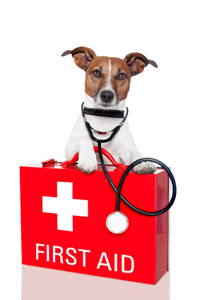
One of the best ways to prepare for an emergency is to have certain supplies on hand, including the following:
- Antibacterial ointment
- Aspirin
- Cotton Balls
- Gauze pads and bandages
- Hydrogen peroxide
- Petroleum jelly - Scissors
- Tape
- Towel
- Tweezers
Having these items on hand will help to ease your mind when you are faced with an emergency situation. Keeping calm is very important because it will help your dog to stay calm as well. You can speak to him/her in a calm, reassuring voice and help him/her to know that everything's okay.
In certain emergency situations, it may be a good idea to muzzle your dog (with an actual muzzle, or even with a necktie or a scarf) to prevent fear biting. Even if your dog never bites, an extreme circumstance may cause him/her to do things that would normally be out of character for him/her, which is another reason to remain calm around him/her.
Cuts and Scratches
Any active dog will get his fair share of cuts and scratches, most of which can be taken care of quite easily. First, thoroughly flush the area with water to make sure the affected area is clean of debris and dirt. Then, apply an antibiotic solution to get rid of germs. You should also apply an antibiotic cream which you can get from your vet, a few times a day until the injury has healed.
If a cut is accompanied by severe bleeding, press a thick gauze pad or towel against the wound to minimize the flow of blood. Then, get your dog to the veterinarian as soon as possible.
Hit by a Car
If your beloved dog is hit by a car, he/she will likely suffer some cuts and scrapes. Try not to move him/her until you are fairly sure there’s nothing significantly wrong with him/her. If he/she must be moved, slide him/her onto a board or a blanket in one swift movement. you will probably need to get him/her to a veterinarian right away.
Try to locate any external wounds that may need the bleeding stopped. Apply pressure to the spot with a bandage or towel, if necessary.
Call your vet immediately and explain the situation. He/she will tell you if you need to go to a clinic. However, any profuse bleeding, broken bones, or other obvious distress signs should immediately tell you that significant medical attention is required.
Ear Infections
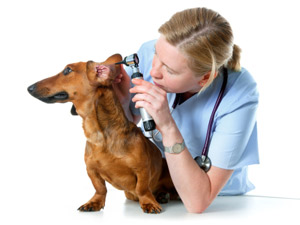
Ear infections are common in many dogs, particularly in breeds with ears that are not erect and/or breeds that have lots of fur on their ears. The most obvious symptom of an ear infection is a smell from the ears. Dogs with ear infections also tend to shake their heads frequently and scratch at their ears. The ears may also be red or have an excessive discharge. If your dog exhibits any of these symptoms, take him/her to the veterinarian as soon as possible.
Senior Dogs
No matter how much you try to deny or ignore it, your dog will not always be a puppy. Some dogs can live 15 years or more, but all dogs will eventually reach their senior years. Older dogs tend to sleep more and play less. They also typically have more health problems.
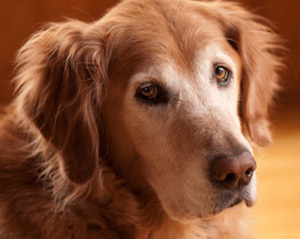
Some health problems may include the following:
Arthritis
Arthritis can cause significant discomfort for a senior dog. He/she may develop a limp, have difficulty lying down or getting up, or no longer be able to make the climb up stairs. The best way to keep your dog feeling good is to make sure he/she gets regular, moderate exercise.
If your dog is struggling on a daily basis, it will be difficult for you to watch. You may want to consider purchasing some products made specifically for older or disabled dogs, such as an orthopedic dog bed, heated blankets, or ramps for access to places that normally require climbing stairs or jumping up.
Blindness
As your dog gets older, his/her vision may begin to deteriorate. This is usually a normal part of the aging process and will not require treatment. It is rare for a dog to become completely blind, or even to lose enough sight to cause a change in his/her quality of life. When your dog's condition worsens you should contact your veterinarian and get help. There are dedicated eye surgery experts to perform surgical operations when it is necessary.
Deafness
Hearing loss is also common in senior dogs, but it generally occurs gradually, so most dogs are able to adjust quite well. As your dog gets older, check his ears often to make sure they are healthy and clean. If necessary, speak louder when you are talking to him/her, and try to incorporate some hand signals so he/she can still understand what you’re saying even if he can’t hear every word that comes out of your mouth.